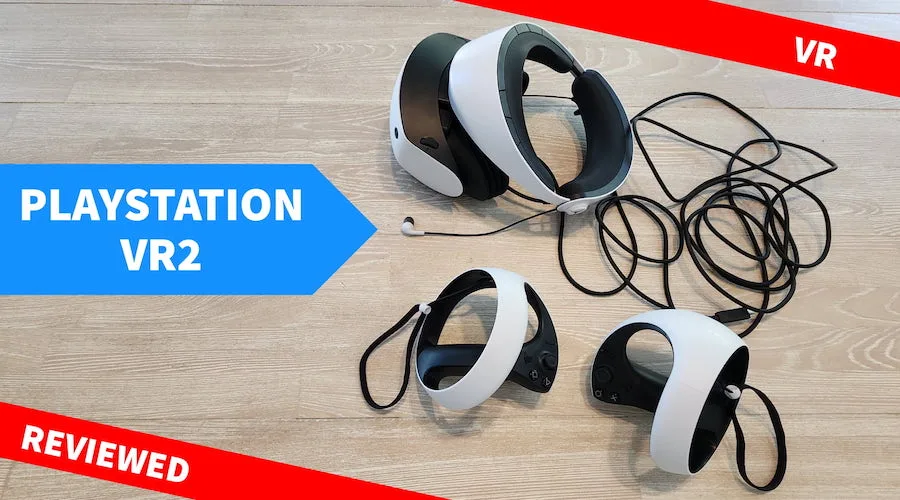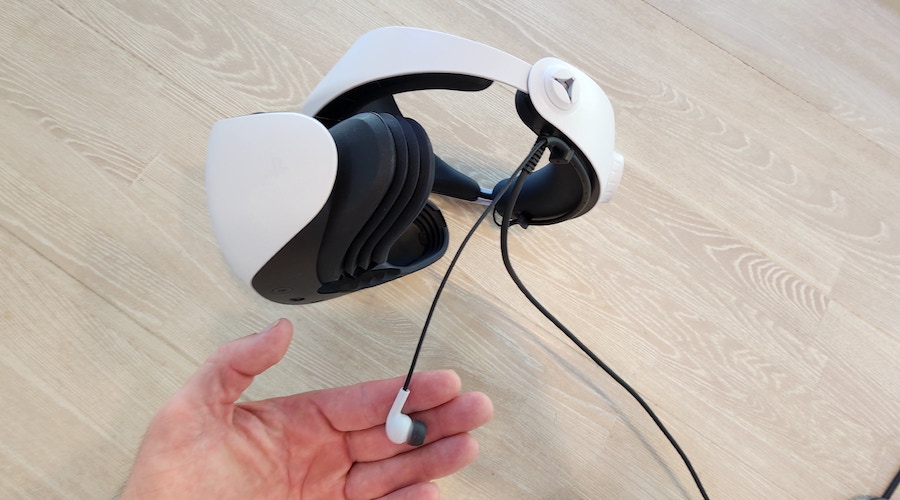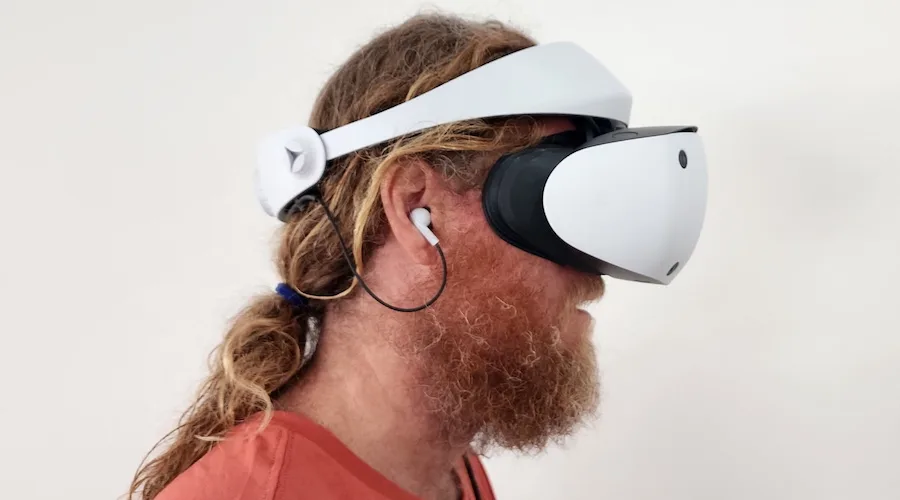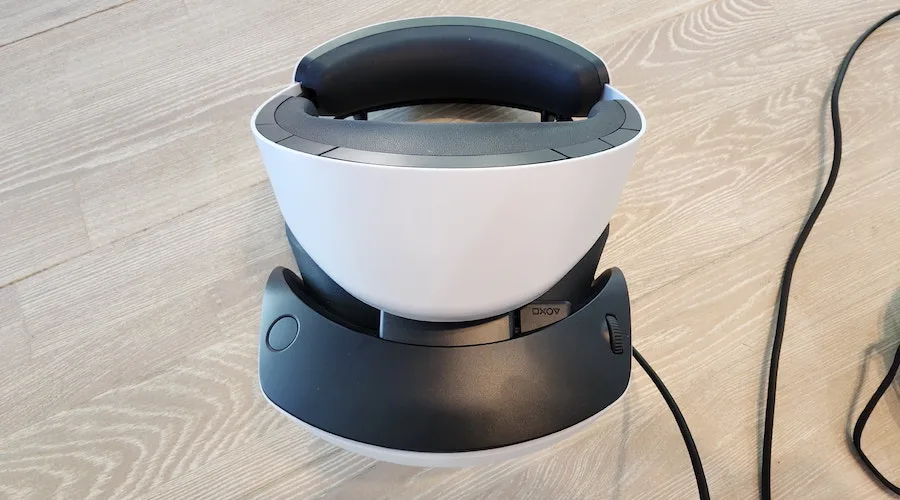PS VR2 review
Summary
As someone who has reviewed all the major VR headsets in the market, I’m happy to report PS VR2 blew me away. The visuals, feedback, controls and sound work together to immerse you in virtual worlds like never before. But I am concerned it’ll age quickly.
- Light and comfortable to wear
- Feature rich
- Stunning and immersive VR experiences
- Too expensive to achieve broader mainstream reach
- Lack of padding around nose
- No wireless or PC options

Image: Chris Stead/Finder
Sony has the power to be the most influential player in the virtual reality space. By leveraging its super popular and considerably powerful PlayStation 5 console as its VR delivery platform, it can reach consumers in a way none of its competitors can.
PS VR2 can deliver a superior VR experience to the wireless offering of Meta Quest 2. But it doesn't require the technical know-how and expensive PC hardware demanded by the HTC Vive Pro 2 and Valve Index.
On top of that, it's a conduit to experiencing VR across some of the biggest franchises in gaming history. Names like Gran Turismo, Horizon, Resident Evil and more.
PS VR2 is rich with potential, but has Sony built a product that can deliver on that promise? It's time to get real in my PS VR2 review.
Buy PS VR2 products
Set-up

Image: Chris Stead/Finder
If you've read some of my previous premium VR headset reviews, you'll know that set-up is a common pain point with PCVR hardware. By comparison, PS VR2 is a breeze.
If you've come from the original PS VR, you'll also love the streamlined connectivity. There's no separate box or camera, and no clutter of cables. Just one USB-C is required, and it plugs straight into the front of your console. Outside of updating the headset and the Sense controllers, you're then good to go.
The cable itself is suitably long, too. Although I was a bit disappointed by how easily it tangles on itself. After one use, it was already screwing together like a vine to a tree and that will just get worse as time goes on.
There's no escaping the cable. I do think Sony shot itself in the foot by not allowing for Wi-Fi 6E support. Even if just as an option for consumers who are willing to take a resolution hit. The hardware will have barely started its lifetime journey by the time wireless VR becomes a standard among competing VR headsets.
At least if current predictions come to pass.
Anyhoo, the UI for the rest of the set-up is wonderful. Eye tracking, defining your room and mapping out your play space is not just a cinch, it's actually fun in its own right. Easily the best I've come across and nailing what's required for that more casual consumer experience.
I also like how "quick VR settings" becomes a shortcut when you press the PS button. Although I would have also liked to have seen a quicker way to adjust height in-game. For example, while playing Gran Turismo 7, it positioned me too low in the driver's seat and there's no quick way to adjust that in-game.
Features

Image: Chris Stead/Finder
Sony's PS VR2 headset is feature rich. On paper it ticks off most of the big-ticket items consumers would expect from a premium headset in 2023. Highlights include eye tracking, foveated rendering, inside-out camera tracking, a crisp pass-through feed, in-built audio, a wide-ranging IPD dial and finger tracking.
It adds to this by incorporating the adaptive triggers and haptic feedback seen in the PlayStation 5 DualSense controllers. While its use feels limited at this stage, it still brings with it an added level of immersion you can't get anywhere else.
But could the headset have been a bit more adventurous? While sporting an impressive 2000 x 2040 resolution, 120Hz refresh rate and 110-degree field of view, there are already aging headsets on the market that beat those specs. As I will go into later, the visual experience is still the best I've come across. But what about in a few years from now?
Similarly, I suspect that competing headsets will emerge in the very near future that can cut the cable and use Wi-Fi 6E to stream VR games. While I can see the argument that comparing PS VR2 to a "what if" scenario isn't fair, by the same token, Sony surely sees this headset having a life span of at least 6 years. If the industry is going in that direction, coming out on the precipice of that evolution without such a vital feature seems risky.
What about PC?
And while not a criticism as such, I'd like to have seen PS VR2 double as a PCVR headset. Sony is actively pushing many of its titles into the PC space, as well as partnering with the likes of Epic Games on metaverse-related activities to which this headset would be a natural fit.
I'm happy to recommend PS VR2 to any PS5 owner, but being able to double up the investment by also utilising PC-driven VR experiences would have been quite the value-add. Maybe such support will come in the future.
Design

Image: Chris Stead/Finder
PS VR2 doesn't look or feel as premium as its features deserve. But as a part of a broader PlayStation ecosystem, I can understand why Sony has tried to pair its appearance to its host console.
What instantly struck me when I first picked up the PS VR2 headset was its weight. It's very light. Almost to the point where it feels flimsy. Indeed, when you run your hand over the head cushioning and the gasket, it lacks the density and plushy feeling of the HTC Vive Pro 2.
My initial fear was this would result in it being uncomfortable to wear. This quickly rose to anxiety when I placed it on my head and felt instant pain across the front of my face: there's no cushioning for your nose at all.
However, a few adjustments later and said pain was gone. You can still occasionally feel the hard plastic of the lenses against your skin, which makes me wish just a hint of padding was on offer, but it wasn't enough to be distracting.
Indeed, thanks to its lightweight chassis, the PS VR2 headset ends up being one of the more comfortable headsets I've worn despite the relative lack of padding. And the soft gasket rubber does an excellent job of stopping light bleed of any sort creeping into the headset.
The way the included earbuds sit in the headset is also an intriguing design choice. It looks cool, but does make the act of putting the headset on a little cumbersome. I will go into their performance more later on, but overall I do like this earbud design more than the off-ear speakers seen in the Pro 2 and Index.
Adjusting the IPD, gasket distance and headband all work a treat. These follow in the same design footsteps of most of the headsets in the space.
The button activating pass-through is welcomed, but positioned too central for my liking. While in VR, when you reach up with your thumb – usually with a Sense controller in hand – it would be easier to access if closer to the edge. In its current position, there's too much fumbling around hunting for it as the controller's orb design wacks into the headset.
Maybe I will adapt over time.
Sense PS VR2 controller
Much like the PS VR2 headset itself, the Sense controllers feel very light in your hands. Those with long memories will recall the DualShock 3 having a similarly flighty feel and like then, I can't help but lament the lack of density. It feels brittle and cheap as a result.
It's comfortable in your hands at least. The design, similar to the Knuckles controller of the Valve Index, can be a little cumbersome at first for newcomers. But once you're in an experience they feel like a natural extension of your body.
I'm less enthused about button placement. Especially during action-heavy experiences, I constantly found myself bumping both the share button and the PS button unintentionally, to the point where I was cursing their existence. You can remap all the buttons as you see fit, but being required to turn things off completely in order to play is, to my mind, flawed design.
Also struggling to stand out as the killer features I had originally envisioned are the adaptive triggers and haptic feedback. I can't say I noticed much of an impact at all in the 10 or so titles I experienced. This could be as much to do with the software as it is the hardware.
The same could be said of finger tracking. In games like Horizon: Call of the Mountain, which are designed to be a showpiece for the tech, it works, but not perfectly. The fingers of your virtual hands do attempt to mimic your movement on the Sense controller, but it's not 1:1.
It approximates it close enough that many players will likely still be impressed, but it's not as good as what I've seen the Valve Index controllers do in titles like Half-Life: Alyx.
Games
Obviously, a VR headset is only ever going to be as good as its software. One of the criticisms that could be levelled at PS VR2 is that it's sectioned off from the vast library of VR experiences available on PC marketplaces like Steam. It even fails to be backwards-compatible with original PS VR games.
Thankfully, Sony's VR headset has launched on PS5 with a robust and diverse library of experiences. True, there's only a handful of new experiences here, but the titles that have been ported over from rival services, or upgraded from PS VR, are among the best available.
I've thoroughly enjoyed the games I've experienced on PS VR2. In part this is due to the fantastic visuals, sound and feedback, which work together to create the most breathtaking sense of immersion money can buy. Horizon: Call of the Mountain delivers one of those genuine "wow" moments, which you rarely get in modern gaming.
This transcends to titles like Gran Turismo 7, Kayak VR, Resident Evil VII, Moss: Book II, No Man's Sky and other heavy hitters. When I think back to playing Gran Turismo Sport on the original PS VR, the leap with GT7 is akin to that of the leap from Super Mario 64 to Super Mario Odyssey. Or PS2 to PS5. It's leagues ahead.
I desperately hope that Sony continues to unleash its big name properties on the platform, and that the headset gets the sales it needs to encourage more third parties to jump on the bandwagon.
But one thing that must happen, is a closing of the gap in terms of the cost of VR titles between PC and PlayStation storefronts. You can build a catalogue of VR games on PC for much cheaper than you can on PS5.
Performance

Image: Chris Stead/Finder
As mentioned above, I wasn't blown away by the PS VR2 specs when it was first announced. But such things can be misleading. It's how the various bullet points combine to produce an overall experience that counts, and in that regard, Sony deserves high praise.
I'd argue that PS VR2 delivers the best virtual reality gaming experience on the market. At least, in 2023. It's a knockout punch. As soon as I got into the first game world, I couldn't help but be impressed. It just looks and sounds so beautiful.
Of particular note is the eye tracking and foveated rendering one-two punch. It works as forecast, and I never picked up on any unfocused regions of the screen. Archaic demons like the screen-door effect and screen tearing are eradicated, too.
I did notice some peculiarities around field of view (FOV). In some titles, the FOV would artificially tighten, as if the developer was acknowledging that the sequence it was rendering would be compromised at full range. This is disconcerting at best, lame at worst. But certainly not a deal-breaker.
The included earbuds work surprisingly well. Initially I had assumed I would ditch these straight away in favour of using the 3D Pulse headset, or the Sony INZONE H9. But I haven't felt a need to do that.
The sound out of the earbuds is strong, and being that they are in-ear, do a great job of blocking out all external sound. I couldn't hear a word my brother was saying as he sat on the couch beside me while testing games like Horizon: Call of the Wild.
As mentioned earlier, there is a "what if" looming over the PS VR2's future and ability to stay relevant. But taken as it is in the "now", I'm very impressed.
Should you buy the PS VR2?
If you're looking for a purist's VR gaming experience, then PS VR2 not only delivers, it does so at a relatively compelling price point. It's comfortable over extended periods of play, feature rich and supported by a strong library of launch titles.
Despite being good bang for buck relative to its peers, PS VR2 still wears a hefty price tag that'll be a stretch for the broader mainstream gamer. This, combined with being gated off from both wireless play and the extended PC space, may restrict sales. And in turn, could deter developer involvement.
For casual gamers then, it may be a case of wait and see. But for hobbyists and the hardcore, PS VR2 is well worth the investment.
Pricing and availability
If you already own a PlayStation 5, then you'll need to find another $879.95 to add PS VR2 into the mix. There's no additional accessories required, but there's an alarming disparity in prices of the games you'll need to use the device.
First-party titles like Gran Turismo and Horizon: Call of the Mountain will set you back in excess of $100. While most other titles hover in the $30–$60 range. So expect to be over the $1,000 mark in no time.
Naturally, if you need a PS5 as well, then you'll have to spend more. The PS5 Digital Edition goes for $649.95 here in Australia, and will do the job.
Comparatively, this is a much bigger investment than a Meta Quest 2. And if you just want to get a more casual VR experience, that's a good direction to go. But when we look at the more premium competitors like HTC Vive Pro 2 and Valve Index, you'll be in for over $2,000. And that doesn't include the PC upgrades you may require to run them and, of course, games.
Granted, there's a bigger library of cheaper games to enjoy on PCVR alternatives. But overall, having experienced the quality of the headset first hand, I'm happy to declare PS VR2 great value for money.

Image: Chris Stead/Finder
Thankfully, Sony has got through the component shortages that led to reduced hardware productivity during COVID. Both the PlayStation 5 console and the PS VR2 headset are readily available at online and offline consumer technology and gaming retailers. Prime members can get overnight delivery of PS VR2 from Amazon.





